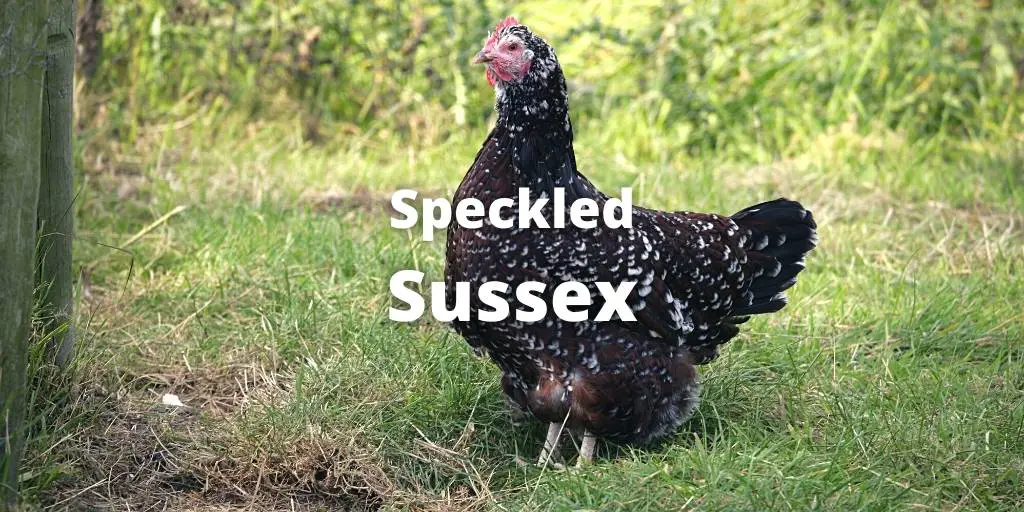The Speckled Sussex chicken is one of the most attractive fowl that most poultry keepers enjoy raising. It comes in both bantam and standard sizes and is a popular dual-purpose show bird.
You will learn everything there is to know about Sussex chickens in this comprehensive breed guide.
It contains standard information about Sussex chickens, such as history, egg production, temperament, lifespan, color, size, appearance, traits, and a care guide.
History and Origin of Speckled Sussex Chickens
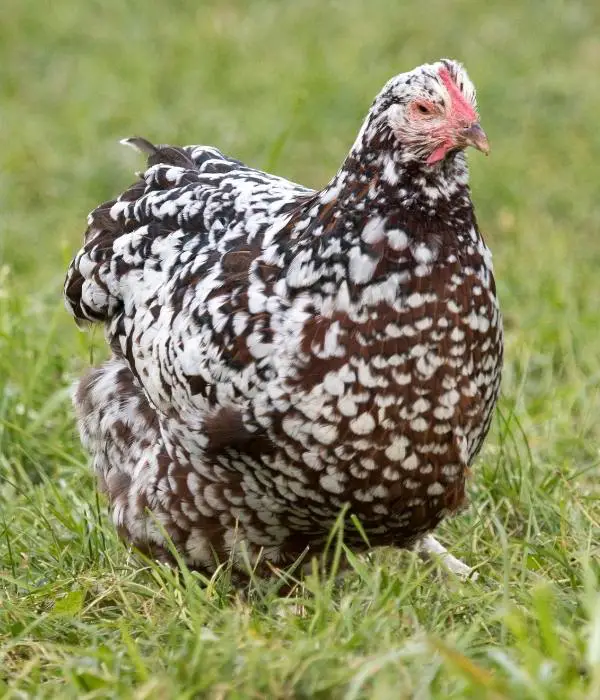
Speckled Sussex Chicken is a type of chicken that originated from Sussex, England, as the name suggests. It was the chicken with the country pride.
Additionally, it was first prized as a table chicken in 1845 and was known as the Kentish fowl.
The first prizing show in 1845 was held at Regents Park Zoo. As a result, they became one of the most popular chicken breeds in the United Kingdom.
As a result, the light Sussex chicken breed aided in the establishment of commercial strains in the country. The Sussex hens were originally brown/reddish during the Roman conquest of 43 A.D.
However, Distinct cross breeds, on the other hand, have resulted in different kinds of Sussex chickens.
Following the outbreak of chicken fever, many people believed the Sussex breed would become extinct. Sussex, on the other hand, was never quite gone. Many people stopped looking for Sussex chickens since their numbers were rapidly dwindling.
Traditionalists, on the other hand, were still on the watch for it, and Sussex was spared. The Sussex Breed Club was founded in 1903. In 1912, the United States of America received England’s prized Light breed of Sussex chicken.
The other Sussex chicken breed was recognized by the American Poultry Association (APA) in 1929. Speckled, Red, and Light variants are among them. On the other hand, the British identify breeds entirely different from those recognized by the APA.
Speckled Sussex Color & Other Linked Varieties
The Speckled Sussex chicken is available in multiple color varieties. The available numerous color varieties of this adorable fowl vary from one continent to another.
The Poultry Club of the United Kingdom accepted the light, red, and speckled in 1902, brown in 1912, buff in 1920, white in 1926, silver in 1948, and Coronation in 1936. However, the Coronation’s original line died out, and therefore it was recreated in the 1980s’.
The American Poultry Association accepted Red and Speckled in 1914 and light in 1928. The Speckled Sussex can be vividly described as heavy, soft feathered with the feathers being closely fitted.
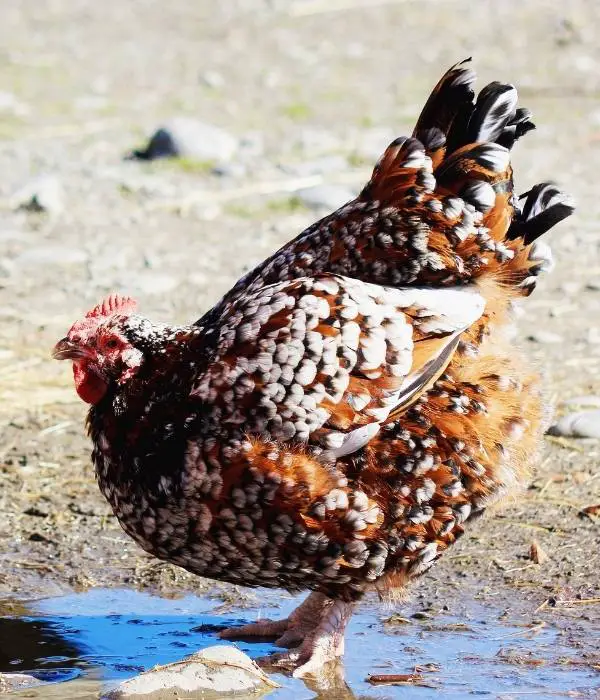
They have a variety of colors. You can easily identify the Sussex chicken breed by its color. The color varieties are:
- Speckled Sussex chicken features a black and white speckled pattern in their entire body. They have base color rich and dark mahogany.
- Light Sussex chicken that features a white body and head. The feathers in their tail and neck are black.
- Red Sussex chicken that has dark, reddish-brown feathers. They are sporadic, and the APA currently recognizes them.
- Brown Sussex chicken is also a rare variety, and their feathers are brown with a black, partridge pattern.
- Buff Sussex chicken is rare, and they feature beige feathers with black markings on their hackle tail and feathers.
- White Sussex chicken is similar to light Sussex but with brighter, pure white feathers. They also have a small black marking on their neck and tail feathers.
- Silver Sussex chicken is also rare. Their body feathers are black with silver penciling on their breast, neck, and head.
- Coronation Sussex chicken is also similar to the light Sussex, but they feature lavender feathers on their neck and tail.
The Lifespan of Speckled Sussex Chickens
Care and their health mainly determine the life span of living creatures. When you take good care of your Speckled Sussex chicken, they will live long.
Poor living conditions and diet may lead to your Speckled Sussex chicken dying early. Speckled Sussex has a lifespan of 8 years or more with good care and a healthy diet.
When you rare them as pets solely for eggs, Speckled Sussex chicken can live for a relatively long period.
Speckled Sussex Temperament
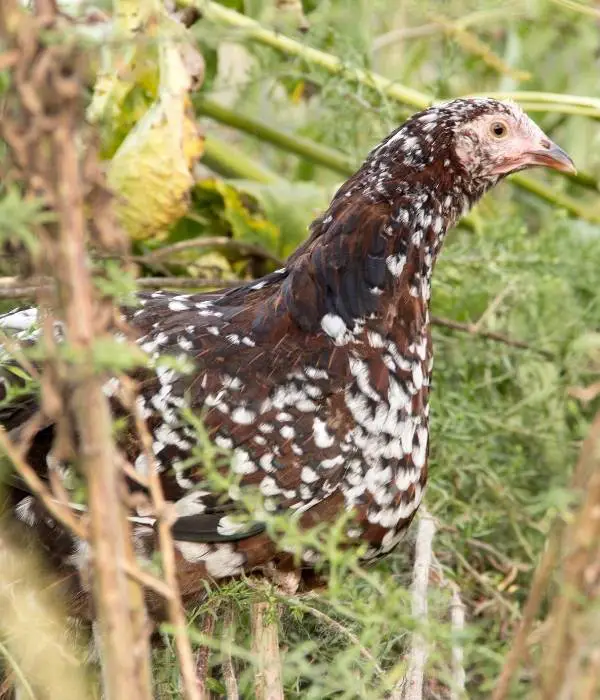
When it comes to friendly chicken breeds, the Speckled Sussex is unbeatable. These hens are calm, docile, and friendly and will happily trot with you in the garden as you dig for grubs and other delectable tidbits.
Because of their inherently curious natures, they are a little naughty. They are busy and resourceful, content to spend their days scratching around in your garden.
They do, however, adapt well to confinement, making them a suitable choice if you want to keep chickens throughout the colder months of the year.
The Speckled Sussex chickens are quiet, only chatting and making the regular backyard chicken noises like the egg-laying song and the alarm call.
The Sussex hen also has a tendency to go broody, which is advantageous if you wish to hatch your eggs. They lay well, and Sussex Hens make excellent moms.
The sole drawback to the Speckled Sussex’s calm demeanor is that it might occasionally fall behind in the pecking order. Other, more assertive chickens may bully it because it is not the largest or most assertive chicken in your coop.
The Speckled Sussex, on the other hand, is a friendly breed that is ideal for poultry keepers with other pets, chicks, and even small children. It’s also an excellent choice for newcomers because it has minimal breed-specific medical or cares concerns.
Speckled Sussex Eggs Production
Sussex hens are well-known for their ability to lay eggs. This is one of the reasons they are so popular among backyard chicken keepers.
They lay large eggs that are cream to light brown, and they weigh 60 to 65 grams. Each year, Sussex chickens can lay 200-250 light brown eggs.
That equates to approximately four to five large size eggs per week per hen. They normally start laying around eight months, which is a little later than other breeds.
Sussex is a fantastic breed to choose from if you want eggs all year. Unlike many other chickens, they will continue to lay eggs during the chilly winter months. Here is a list of a few best cold hardy chickens.
It will, however, realistically slow down until spring, when the weather warms up again. They will only cease laying when they molt, which is something that all hens do.
Chickens are unable to produce eggs during molting because they are consuming all of their nutrients to restore their feathers.
Within the first few years of their lives, they will lay the most eggs. When they are around five years old, their egg production begins to slow down, producing fewer eggs.
Color, Size, Appearance, Characteristics of Speckled Sussex chickens
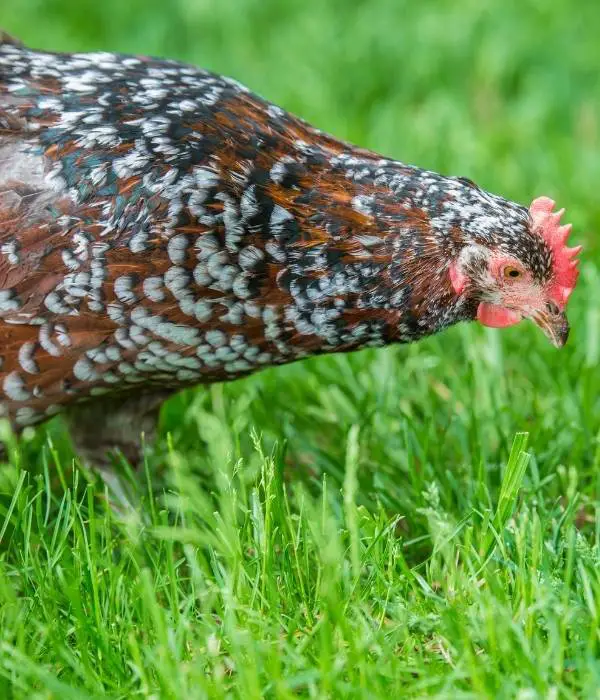
Color
The Speckled Sussex chickens have rich and dark mahogany color in base with white speckled plumage that gets better with successive molts.
Size
Speckled Sussex chicken is not small and not that large. They are relatively medium in size.
The average weight for roosters is 8 pounds or more. The hens are around 6 to 7 pounds. A bantam rooster can weigh about 36oz, while a hen can be approximately 30oz.
Appearance
Sussex chickens have a beautiful and graceful body shape. These adorable birds feature heavy and rectangular-shaped bodies with wide shoulders, and their backs are broad.
Furthermore, all colors look fantastic on all of the breed’s variants. Sussex has extremely soft feathers that cover the entire body.
The tail feathers are entirely black and have a nice 45-degree bend angle. Sussex’s earlobes are crimson. This fowl’s legs and skin are white.
Because of its multi-color plumage and white patches, the Speckled Sussex chicken is quite attractive. Sussex chickens are lovely, cute chicken breeds.
Depending on the variety, their eyes are orange or red. Their horn color beak, red color comb, and wattles. The Speckled Sussex has a single type comb.
Characteristics
They have long, broad backs. The Sussex chicken breed features rectangular bodies with wide shoulders. This bird breed is easy to handle, thanks to its stout nature.
Both the Speckled Sussex hens and roosters have a perky look. When you look at the Sussex chicken breed, you will see their tail held at 45 degrees.
The Sussex chicken breed has close-fitted feathers. Therefore, when you look at these birds, they look full except for their tails that are not closely fitted and are held at 45 degrees.
They have a beautiful red color single-type comb. The Speckled Sussex has white legs with four toes each.
Speckled Sussex hens are good mothers and excellent foragers. They take care of their baby chicks very well.
Speckled Sussex Hen Vs Rooster
Speckled Sussex roosters are much larger than hens. When it comes to the comb and wattles, the roosters’ combs are on top of their head while the wattle is more noticeable compared to the ones for hens, and they are redder. The roosters are heavier than the hens. Only Speckled Sussex Hen lay eggs.
Benefits of Raising Speckled Sussex chicken
You can raise Sussex chickens if you want a breed that lays a lot of eggs. This breed lays typically 220-250 eggs each year; however, they can lay up to 300 on rare occasions.
Sussex chickens typically weigh around 4 kg, making them fine meat birds. This breed is easy to rear; thus, it’s an excellent choice if you’re a beginner chicken keeper.
They can be kept as pets, for meat, and for laying eggs. Also, the Speckled Sussex loves to play with kids.
They are active and great foragers, and therefore you do not need much money to keep them.
Thanks to their unique feathering, they can camouflage themselves from predators such as hawks, coyotes, and foxes.
Problems in Raising Speckled Sussex chicken
• The birds aren’t overly concerned about predators. Wild dogs, foxes, and cats kill them most of the time because of their gregarious nature. Make a predator-proof coop and run for your chickens to ensure safety.
• They have a kind demeanor with their owners, yet they are terrified of strangers and flee.
• They may wander far away from home.
Also read: Best electric fencing for chicken coop
Speckled Sussex Chicken Breed Care Guide
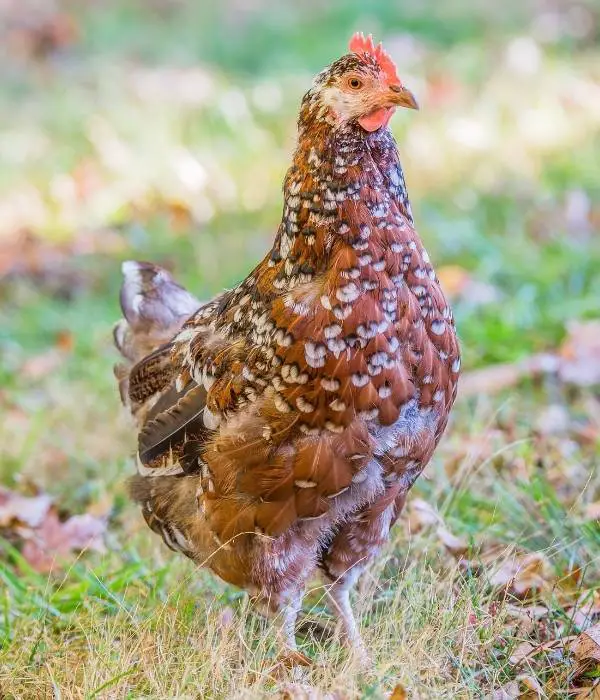
Below are a few basic care guide tips for raising Speckled Sussex:
Coop Setup
At least 4 square feet of coop space is required for each of your Speckled Sussex. They aren’t known for pecking or arguing, but boredom will eventually set in over the long, hard winters, and mischief may develop.
Having ample space inside will aid in reducing this behavior. Make sure they each have 8-10 inches of perch area.
If they have to share roosting space with more assertive breeds, make sure they have their perches so they may be alone. Finally, a normal 1212-inch box will be enough for nesting boxes (any larger, and they will share nests).
One nesting box should be provided for every three chickens. They’ll always have a favorite box that they want to use.
Feeding
A general 16 percent layer feed can be fed to laying hens. Furthermore, they will require calcium in the form of an oyster shell.
You should raise the protein amount of their feed to 20% when she starts to molt. This will aid in their rapid feathering without depleting their protein stores.
Also, if they are kept in a pen, you will need to supplement their diet with chicken grit to aid digestion. Except during the winter months when the ground is frozen, free-range hens do not require additional grit.
Health Issues
This is a strong and hardy fowl. As long as they have proper housing, they can survive a broad range of climates, from winter to heat.
Fortunately, they are not susceptible to infections other than the regular illnesses affecting chickens. Check for lice, mites, and worms on a regular basis because parasites (both internal and external) can create difficulties.
They’re also known for being somewhat broody; while this isn’t a health concern, it’s something to be aware of. Sussex hens are popular for sitting patiently and then teaching their chicks everything they need to know about becoming a chicken.
Run and Roaming
The speckled Sussex enjoys roaming freely, and their hue helps hide them from predators. She is a skilled forager who will be able to augment her diet with a variety of treats.
If ticks are an issue in your area, chickens such as the Sussex will swiftly reduce the number. If you can’t let them run free, they’ll put up with being on a run.
Make sure they each have an 8-square-foot running area. To keep children from being bored, you should provide them with a range of toys.
Consider providing a variety of perches at various heights and tree stumps, swings, and calm locations for the flock’s more frightened individuals.
Summary
Speckled Sussex chicken comes in a variety of colors, from red and white to silver and speckled, and has lovely orange to red eyes.
The Speckled Sussex is the oldest color variant and the slowest to mature, while the Light Sussex is the most well-known variety with its lovely black trim.
Because they are low maintenance, friendly, and one of the top egg-laying breeds, the Sussex chicken is a lovely and one of the best backyard chicken breeds for keepers.
They’re also ideal for families searching for a docile yet self-assured chicken that’s simple to handle. I hope after reading this guide you will know all about Speckled Sussex chickens.
